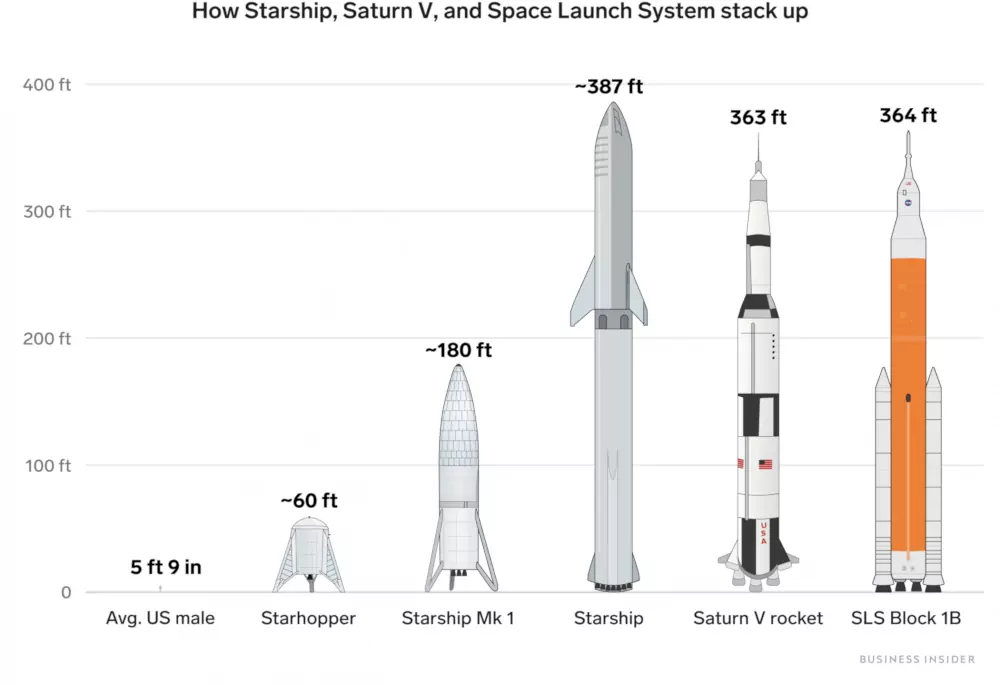Elon Musk recently tweeted about the logistics requirements for a Multiplanetary civilisation. He says that at a minimum, megatons of equipment and other resources have to be put in orbit every year. For reference, a Saturn V (the launch vehicle used to send humans to the moon), can take a payload of around 140 tons to Low Earth Orbit. A launch of Saturn V costs $1.23 billion (in 2019 value). To reach the goal of a megaton per year there would have to be more than 7000 launches per year, or 20 launches per day! That would cost $8.8 trillion(!). But of course, technology has come a long way since 1969.
Megatons per year to orbit are needed for life to become multiplanetary
— Elon Musk (@elonmusk) January 17, 2020
Starship #

Size comparison of Starship and Saturn V. Source.
Elon Musk claims that SpaceX’s Starship can take upto 3 flights per day! With more than 100 tons of payload capacity (comparable to the Saturn V), a single Starship could take more than 100,000 tons per year.
Building 100 Starships/year gets to 1000 in 10 years or 100 megatons/year or maybe around 100k people per Earth-Mars orbital sync
— Elon Musk (@elonmusk) January 17, 2020
Doing the calculations, Elon says that SpaceX could take 100,000 people per decade to Earth-Mars orbit. But wait! We are not there yet, going to Mars takes longer than that. The Earth-Mars transfer window occurs every 26 months and it takes 9 months to reach Mars after that, which means people would have to survive for 3 years in space before reaching Mars. For reference, the record for longest single stay in space in human history is 14 months.
Coming back to the point, 100K people per decade would mean an estimated 1 Million humans on Mars by 2050.
Yes
— Elon Musk (@elonmusk) January 17, 2020
That’s… 0.00013% of the world population… in 30 years.
That’s way too slow. Moreover, looking at the history of Elon (and Tesla) with schedules, it could take much longer. Even though 1 million is a large number of people (to be on Mars), it will take centuries before a large part of humanity is on Mars. This will further divide humanity into Earth-dwelling low lifes and fortunate Martians, separated physically by 300 million kilometers of empty space.
Life on Mars #
Who gets to go to Mars? The rich? The fortunate? The skilled (who can set up a colony on Mars)? Elon says anyone with money can go.
Needs to be such that anyone can go if they want, with loans available for those who don’t have money
— Elon Musk (@elonmusk) January 17, 2020
How do you pay for a loan on Mars? By working.
Yes. There will be a lot of jobs on Mars!
— Elon Musk (@elonmusk) January 17, 2020
So, unless you have enough money, you’ll have to work in dangerous conditions on Mars.
But wait, SpaceX isn’t the only space company #
Of course, there’s NASA, Blue Origin, Roscosmos (A government website without HTTPS, classic.), ISRO and others.
NASA is working on a mission to send humans to Mars by first going the moon and making it a checkpoint (Related: Moon is a part of Mars). For this mission, NASA will work with companies from the so-called “Billionare Space Race”, including SpaceX and Blue Origin.
Travelling isn’t the only problem #
Even if SpaceX can send humans to Mars, that will only cover one part of the problem. People have to live and survive not only on Mars but also during the journey. There is also the problem of communication, it could take anywhere between 4 and 24 minutes for a signal to travel from Earth to Mars or vice-versa.
Final words #
Though there are a lot of issues with humans having a multiplanetary civilisation, it is a very exiciting time for space travel. Even if just a single person steps on Mars, that will be a great achievement for mankind (“one giant leap”, you could say ;-P).
Resource-constraint private companies like SpaceX have brought efficiency to the table through their re-usable rockets. Multiple space agencies working together towards a common goal is a great boon to space travel. It truly is an exiciting time!
Hopefully, I’ll be reading this in my fungi-grown home on Mars sometime this century :-)
PS: This is my first (real) blog post and there might be will be many mistakes. Please leave a comment if you find this interesting
or if you have any opinions/facts to share. Thank you for reading!